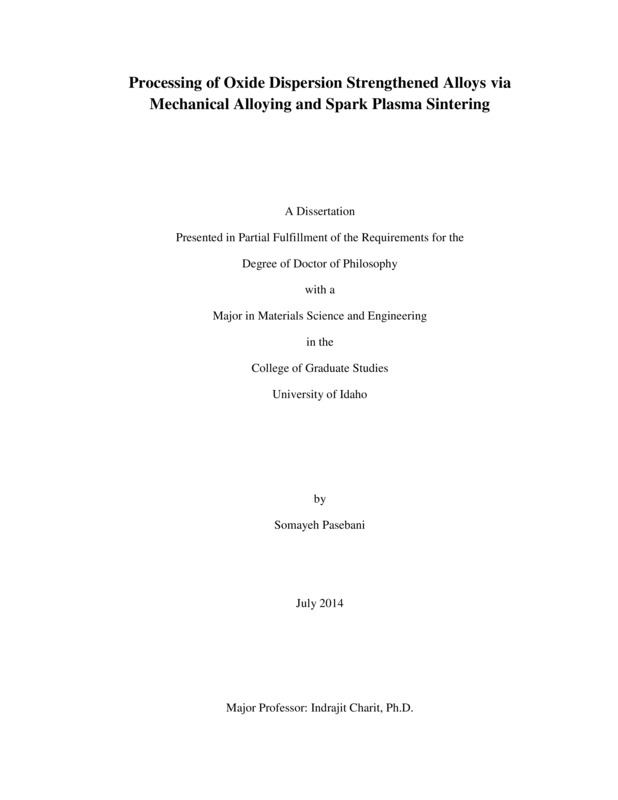Processing of Oxide Dispersion Strengthened Alloys via Mechanical Alloying and Spark Plasma Sintering
Pasebani, Somayeh. (2014). Processing of Oxide Dispersion Strengthened Alloys via Mechanical Alloying and Spark Plasma Sintering. Theses and Dissertations Collection, University of Idaho Library Digital Collections. https://www.lib.uidaho.edu/digital/etd/items/pasebani_idaho_0089e_10394.html
- Title:
- Processing of Oxide Dispersion Strengthened Alloys via Mechanical Alloying and Spark Plasma Sintering
- Author:
- Pasebani, Somayeh
- Date:
- 2014
- Keywords:
- Iron-based ODS alloys Lanthanum Oxide Mechanical Alloying Nickel-based ODS alloys Oxide Dispersion Strengthened Alloys Spark Plasma Sintering
- Program:
- Chemical Engineering and Materials Engineering
- Subject Category:
- Materials Science; Engineering
- Abstract:
-
Oxide dispersion strengthened (ODS) alloys are potential candidates to be used as high temperature structural materials in advanced nuclear and fossil energy systems because of highly stable microstructure and high creep strength. The high temperature properties of these alloys are caused by high density of dislocations and grain boundaries that are effectively pinned by ultrafine YTi-enriched particles. The traditional processing method of ODS alloys is via mechanical alloying (MA) of high chromium content powder in combination with up to 0.5 wt.% Y2O3, followed by hot consolidation via hot extrusion or hot isostatic pressing. In the current study, Fe-based ODS and nickel-based ODS alloys are developed by using spark plasma sintering (SPS). Furthermore, in Fe-based ODS alloys or so called nanostructured ferritic steels, Y2O3 is replaced by equal atomic percent of La2O3. Then, the effects of alloying composition, processing parameters including milling parameters and sintering parameters, on the microstructure characteristics and mechanical properties of the milled powder and consolidated alloys were investigated and structure-properties were correlated. Several Fe-14Cr based alloys with varying compositions were processed. Microstructural characteristics of the consolidated alloys were examined via transmission electron microscopy and atom probe tomography, and mechanical properties were evaluated using microhardness testing, shear punch testing and mini-compression testing. Lanthanum oxide (0.5 wt.%) was added to Fe-14Cr leading for improving microstructural stability and mechanical properties mainly due to a high number density of La-Cr-O-enriched nanoclusters (NCs). The combined addition of La, Ti (1 wt.%) and Mo (0.3 wt.%) to the Fe-14Cr base composition further enhanced the microstructural stability and mechanical properties. The NCs enriched in Cr-Ti-La-O with a number density of 1.4×1024 m−3 were found in this alloy (sintered at 950 C for 7 min) with a bimodal grain size distribution. Formation mechanism of these NCs can be explained through the concentrations and diffusion rates of the initial oxide species formed during the milling process and initial stages of sintering as well as the thermodynamics nucleation barrier and their enthalpy of formation. Milling provided solid solution, high density of dislocations, vacancies in the powder and facilitated the nucleation of NCs and enhanced the densification behavior by initiating sintering at lower temperatures while lowering the activation energy for both grain boundary and volume diffusion. Significant densification occurred at temperatures greater than 950 oC with a relative density higher than 98%. High mechanical strength values were achieved in room and high temperature are due to the combined strengthening mechanisms of work hardening, grain refinement, dispersion strengthening and solid solution strengthening. The microstructure of lanthana-bearing NFS was stable after self-ion irradiation at 500 C up to 100 dpa. A notable irradiation hardening and enhanced dislocation activity occurred after irradiation.
On the other hand, nickel-based oxide dispersion strengthened (ODS) alloys were developed by adding 1.2 wt.% Y2O3 to Ni-20Cr matrix via MA and SPS. Additionally, 5 wt.% Al2O3 was added to Ni-20Cr-1.2Y2O3 to provide composite strengthening. Higher sintering temperature led to higher fraction of recrystallized grains, higher hardness, density, and higher volume fraction of annealing twins. Adding 1.2 wt.% Y2O3 to the Ni-20Cr matrix significantly reduced the grain size. Higher compression yield stress at 800 C for Ni-20Cr-1.2Y2O3-5Al2O3 alloy was attributed to a combined effect of dispersion and composite strengthening.
- Description:
- doctoral, Ph.D., Chemical Engineering and Materials Engineering -- University of Idaho - College of Graduate Studies, 2014
- Major Professor:
- Charit, Dr. Indrajit
- Committee:
- Raja, Dr. Krishnan S.; Pesic, Dr. Batric; Cole, Dr. James I.; Bakhtiar, Dr. Steven N.
- Defense Date:
- 2014
- Identifier:
- Pasebani_idaho_0089E_10394
- Type:
- Text
- Format Original:
- Format:
- application/pdf
- Rights:
- In Copyright - Educational Use Permitted. For more information, please contact University of Idaho Library Special Collections and Archives Department at libspec@uidaho.edu.
- Standardized Rights:
- http://rightsstatements.org/vocab/InC-EDU/1.0/

